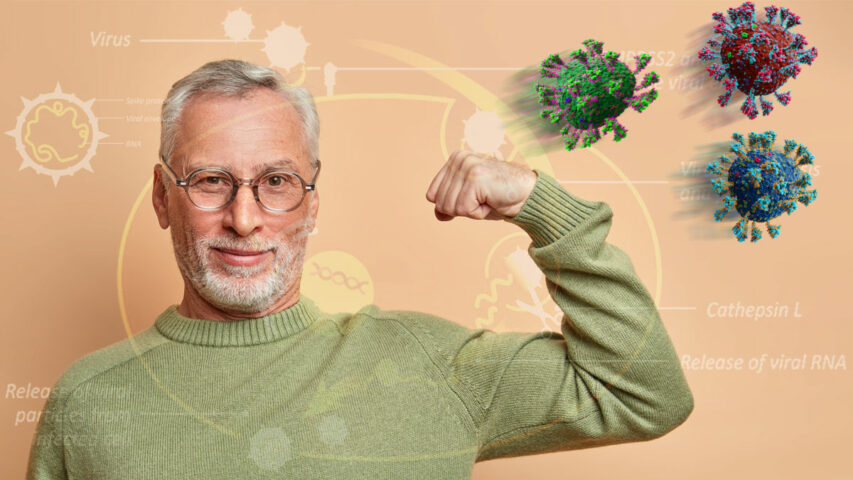- Have any questions? Contact us!
- info@dr-rath-foundation.org

Omega-3 Fatty Acids Linked With Slower Progression Of Amyotrophic Lateral Sclerosis
June 29, 2023
Vitamin D May Alleviate Menstrual Cramping
July 5, 2023Nutrient Mix Designed at Dr. Rath Research Institute is Effective Against Different Types of Coronavirus

In this new study we wanted to find out whether certain natural substances could help fight against SARS-CoV-2 (the virus that causes COVID-19), and another type of coronavirus known as HCoV-229E which infects humans and is associated with the common cold and its symptoms.
The importance of the study relates to the fact that COVID-19 is still a big problem, especially for older people and those with weak immune systems. Current approaches using RNA- and DNA -based vaccines are not effective in preventing the infection and spread of SARS-CoV-2, or its variants such as Omicron. The anti-viral drugs used against the pandemic are similarly not fully effective. It is therefore important to develop other approaches, especially those involving safe, natural substances, that could be used alongside or instead of conventional treatments.
For the study, scientists at the Dr. Rath Research Institute used a combination of natural substances including vitamin C, polyphenols, and other nutrients. They gave the nutrient mix to mice infected with one or other of the two types of coronaviruses, to see if it could reduce the numbers of viral particles and spike proteins in the animals’ lungs.
Based on our earlier work using human cells growing in culture we already knew that the combination of nutrients in this mixture was effective in controlling key cellular mechanisms of SARS-CoV-2 infection, including inhibiting the multiplication of the virus.
We had found that the nutrient mix could inhibit an enzyme, RNA-dependent RNA polymerase (RdRp), which is needed for a virus to make copies of itself. The mix was also effective in preventing viral spike protein from binding to cell surfaces and entering cells. It additionally worked in decreasing the number of so-called ACE2 receptor proteins, which are expressed by cells in the lungs, blood vessels, and other organs, and that help the virus to get into cells.
In this latest study the nutrient mix was administered daily to mice infected with either SARS-CoV-2 or HCoV-229E, to see if it could reduce infectivity in terms of the amounts of viral particles and spike proteins found in the lungs. Infected mice in the control group were fed a normal diet without nutrient supplementation. The amounts of viral particles and spike proteins in the lungs were evaluated using special molecular-based tests. We also examined the effects of the nutrient mix on the presence of immune cells in the lungs, as an indication of tissue inflammation.
The results showed that, compared to mice in the control group, the nutrients significantly reduced the amounts of viral particles and spike proteins in the lungs of infected mice. Moreover, the mix was equally effective in mice infected with either of the two types of coronaviruses. This indicates that the nutrients affected common mechanisms of infection and were not specific to a particular type of virus. It also explains the results of our previous studies, which showed that the nutrient mix was effective in stopping SARS-CoV-2 and several of its mutated forms, including Omicron variants, from entering the cells.
Crucially, we found the nutrient mix affected not only the virus itself; it also reduced the ability of the virus to enter cells by decreasing the number of ACE2 receptors on cell surfaces. In the presence of inflammation, which is commonly associated with infections, there were similarly less ACE2 receptors on cells. Nutrient anti-inflammatory effects were also observed in the lung tissue of the mice.
In conclusion, our study showed that the nutrient mix could help reduce the infectivity of SARS-CoV-2 and the associated common cold virus HCoV-229E in mice at different stages of infectivity. The fact that different mechanisms were affected simultaneously demonstrates the superior efficacy of nutrients compared to drugs, the latter of which usually target only a single mechanism and allow the virus to escape by mutating.
The unique composition and efficacy of our nutrient mix has been awarded US and international patents. While more research is needed in order to fully confirm its efficacy in human clinical trials, the application of this safe micronutrient combination as soon as possible should ultimately benefit people worldwide and save on healthcare costs.




